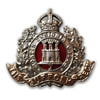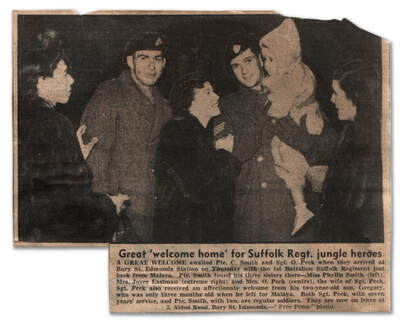2019 Friends News
2019 was a quiet year for the Friends. Membership remained steady and the interest was maintained with the Regiment after the centenary of the Great War had ended. Although website visits dropped, we were not downhearted. We revelled in the success of having saved the 15th Battalion Colour from destruction and returned it to the Regimental Chapel for safekeeping. We took a surviving NW Europe veteran back to Hamont for their 75th anniversary Liberation ceremony, and worked closely with the Old Comrades Association Leiston to keep it in existence for another year. You can read all our news of the year below:
As 2019 Draws To A Close...
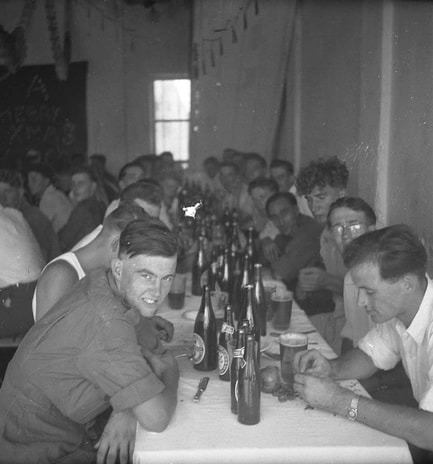
As we say goodbye to 2019, we look back on another fantastic year for the Friends. Achievements may have been reduced in previous years, and the living face of the Regiment continues to decrease, but the Friends are still very much alive.
2019 saw us celebrate our 11th birthday and take a Suffolk veteran back to his former battlefields in Europe. We saved endangered Regimental Colours by the generosity of our members and overtook the custodianship of an important Regimental Memorial in Leiston.
We produced yet more great magazines telling of previously unrecorded Regimental History and helped many of our members with their research. Membership is however, the key to ensuring our survival. If we are to survive into the next century, we do need more members so, if you are not a member, please do go to the 'Join Us' page of this website and download a membership form.
Here's to our twelfth year celebrating the history and traditions of the Old Twelfth of Foot!
(Posted: 31/12/2019)
2019 saw us celebrate our 11th birthday and take a Suffolk veteran back to his former battlefields in Europe. We saved endangered Regimental Colours by the generosity of our members and overtook the custodianship of an important Regimental Memorial in Leiston.
We produced yet more great magazines telling of previously unrecorded Regimental History and helped many of our members with their research. Membership is however, the key to ensuring our survival. If we are to survive into the next century, we do need more members so, if you are not a member, please do go to the 'Join Us' page of this website and download a membership form.
Here's to our twelfth year celebrating the history and traditions of the Old Twelfth of Foot!
(Posted: 31/12/2019)
Merry Christmas!
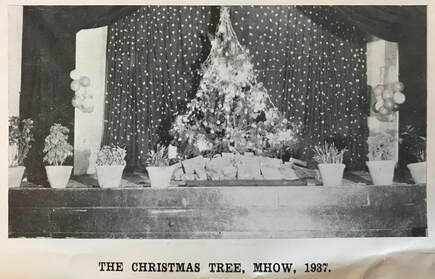
A very Merry Christmas to you all!
(Posted: 25/12/2019)
(Posted: 25/12/2019)
'Pop' Whitwell
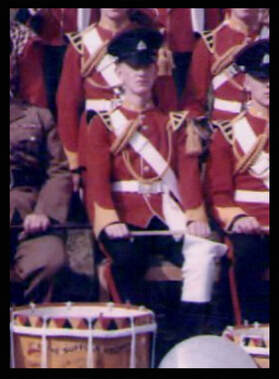
It is with profound sadness that we have learnt of the passing of Suffolk Regiment stalwart, Pop Whitwell, who has passed away having been ill for some time.
Pop was a member of the Corps of Drums, serving with the 1st Battalion in Germany in 1955, and in Cyprus in 1956. He was we believe one of the last surviving drummers who was present at the Colours Parade at Wuppertal in May 1955, where this rare colour photograph of him seen here, was taken.
In retirement, Pop was a staunch supporter of Regimental events for both the Suffolk Regiment and the Cambridgeshire Regiment, with whom he completed his Territorial Army Service. He was an active member of the Whittlesea Branch of the Cambridgeshire Regiment Old Comrades Association and an ardent collector of Suffolk Regiment memorabilia, even turning over the garage at his home to create a small private museum of artefacts.
Our thoughts are with his family, and his widow, Sylvia, at this difficult time.
(Posted: 23/12/2019)
Pop was a member of the Corps of Drums, serving with the 1st Battalion in Germany in 1955, and in Cyprus in 1956. He was we believe one of the last surviving drummers who was present at the Colours Parade at Wuppertal in May 1955, where this rare colour photograph of him seen here, was taken.
In retirement, Pop was a staunch supporter of Regimental events for both the Suffolk Regiment and the Cambridgeshire Regiment, with whom he completed his Territorial Army Service. He was an active member of the Whittlesea Branch of the Cambridgeshire Regiment Old Comrades Association and an ardent collector of Suffolk Regiment memorabilia, even turning over the garage at his home to create a small private museum of artefacts.
Our thoughts are with his family, and his widow, Sylvia, at this difficult time.
(Posted: 23/12/2019)
'Tis The Season...
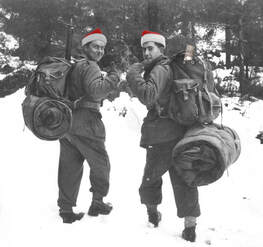
It's that time of year again where we wish all Friends past and present, the compliments of the festive season.
Why not give the one you love, a membership by going to the 'Join us' page of this website.
Merry Christmas!
(Posted: 21/12/2019)
Why not give the one you love, a membership by going to the 'Join us' page of this website.
Merry Christmas!
(Posted: 21/12/2019)
In Search Of The Real 'Suffolk Hill'
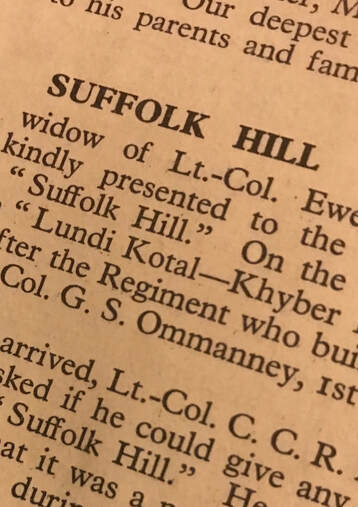
For the Regimental Historian it is most frustrating that of late, the memorial to the British II Corps at Le Cateau, has been dubbed as "Suffolk Hill".
"Suffolk Hill" is actually just outside Colesberg in South Africa, where on 6th January 1900, the 1st Battalion suffered a bitter defeat at the the hands of the Boers after a confused night attack on the hill northwest of the town. In the days following the battle, the Battalion's dead were collected into a single grave and a stone cairn was erected soon afterwards. This hill was renamed "Suffolk Hill" by the Boers in honour of their attackers gallant efforts to take it.
There is another "Suffolk Hill" in the Khyber Pass between Pakistan and Afghanistan. Here on a rocky outcrop was a hill station named after is occupants in the the late 1870s and it is this position that we are seeking information on. A map or sketch of the position is known to have existed being given to the Regimental Museum in 1949, but its current whereabouts are unknown.
The II Corps memorial at Le Cateau it is true, sits directly upon 'B' Company's position in the battle which took place there in 1914, but its renaming in recent years is due in part, to lazy tour guides visiting the spot now telling their parties that its the Suffolk Memorial at "Suffolk Hill". This may stem from also from the 'Planet Suffolk' website which also names it as 'Suffolk Hill'. In fact, just one panel of the memorial is dedicated to the 2nd Battalion; the others being to other units engaged in the battle. Another panel is dedicated to the losses of the Manchester Regiment, which was originally the 63rd of Foot (West Suffolk) and maybe this is where the 'Suffolk-isation' may have stemed from.
However, if anyone has any information on the Khyber Pass 'Suffolk Hill' please do let us know.
(Posted: 20/12/2019)
"Suffolk Hill" is actually just outside Colesberg in South Africa, where on 6th January 1900, the 1st Battalion suffered a bitter defeat at the the hands of the Boers after a confused night attack on the hill northwest of the town. In the days following the battle, the Battalion's dead were collected into a single grave and a stone cairn was erected soon afterwards. This hill was renamed "Suffolk Hill" by the Boers in honour of their attackers gallant efforts to take it.
There is another "Suffolk Hill" in the Khyber Pass between Pakistan and Afghanistan. Here on a rocky outcrop was a hill station named after is occupants in the the late 1870s and it is this position that we are seeking information on. A map or sketch of the position is known to have existed being given to the Regimental Museum in 1949, but its current whereabouts are unknown.
The II Corps memorial at Le Cateau it is true, sits directly upon 'B' Company's position in the battle which took place there in 1914, but its renaming in recent years is due in part, to lazy tour guides visiting the spot now telling their parties that its the Suffolk Memorial at "Suffolk Hill". This may stem from also from the 'Planet Suffolk' website which also names it as 'Suffolk Hill'. In fact, just one panel of the memorial is dedicated to the 2nd Battalion; the others being to other units engaged in the battle. Another panel is dedicated to the losses of the Manchester Regiment, which was originally the 63rd of Foot (West Suffolk) and maybe this is where the 'Suffolk-isation' may have stemed from.
However, if anyone has any information on the Khyber Pass 'Suffolk Hill' please do let us know.
(Posted: 20/12/2019)
Ken Ambrose
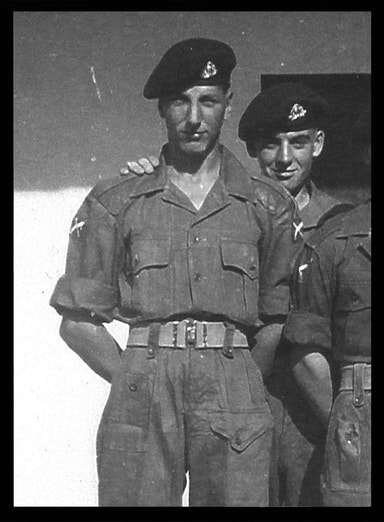
It is with sadness that we have to report the passing of Friend Ken Ambrose who passed away after a short illness.
Ken was a National Serviceman. After completing his basic training with the Bedfordshire and Hertfordshire Regiment, he was posted to join the 1st Battalion, then serving in support of the civil powers in Malaya.
Ken was posted to 8 Platoon, 'C' Company then under the command of Lieutenant F.A. Godfrey, and was we believe, one of the last two men who were part of a patrol in May 1951, that was ambushed, wounding the platoon officer and sergeant. A young Lance Corporal, Bill Price, assumed command and skilfully extricated the section and the wounded. For his actions that day, Price was awarded the Distinguished Conduct Medal.
Ken remained close to the Regiment. He was a regular attendee at Minden Day and at John Blench's Pig Roasts in the late 1990s and early 2000s. He was an early member of the Hemel Hempstead Branch of the Old Comrades Association and was a donor to the Friends Appeal to purchase Bill Price's DCM when it was offered for sale. Thanks to Ken's and other's generosity, his medals are now in the Suffolk Regiment Museum.
Our thoughts are with his family at this difficult time.
(Posted: 07/12/2019)
Ken was a National Serviceman. After completing his basic training with the Bedfordshire and Hertfordshire Regiment, he was posted to join the 1st Battalion, then serving in support of the civil powers in Malaya.
Ken was posted to 8 Platoon, 'C' Company then under the command of Lieutenant F.A. Godfrey, and was we believe, one of the last two men who were part of a patrol in May 1951, that was ambushed, wounding the platoon officer and sergeant. A young Lance Corporal, Bill Price, assumed command and skilfully extricated the section and the wounded. For his actions that day, Price was awarded the Distinguished Conduct Medal.
Ken remained close to the Regiment. He was a regular attendee at Minden Day and at John Blench's Pig Roasts in the late 1990s and early 2000s. He was an early member of the Hemel Hempstead Branch of the Old Comrades Association and was a donor to the Friends Appeal to purchase Bill Price's DCM when it was offered for sale. Thanks to Ken's and other's generosity, his medals are now in the Suffolk Regiment Museum.
Our thoughts are with his family at this difficult time.
(Posted: 07/12/2019)
Regimental Gazettes - Can You Help?
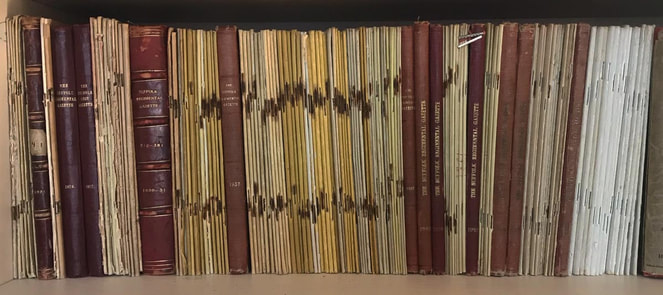
The recent purchase of some copies of the 'Suffolk Regimental Gazette' has allowed us to fill in a few gaps in our collection, however we have many more yet to find. We do now however have a few duplicates for years 1935-1959, and a few of the 'Britannia and Castle' that followed it.
As a start were missing the following numbers between 1935 and 1959, but if you have any spares, please do get in contact with us and we may be able to do a swap with you.
Wanted:
No. 405 (November-December 1935)
No. 426 (May-June 1939)
No. 470 (November-December 1946)
(Posted: 30/11/2019)
P.s. were always looking for early editions!
As a start were missing the following numbers between 1935 and 1959, but if you have any spares, please do get in contact with us and we may be able to do a swap with you.
Wanted:
No. 405 (November-December 1935)
No. 426 (May-June 1939)
No. 470 (November-December 1946)
(Posted: 30/11/2019)
P.s. were always looking for early editions!
Stable Belts: Buckled Front Or Side?
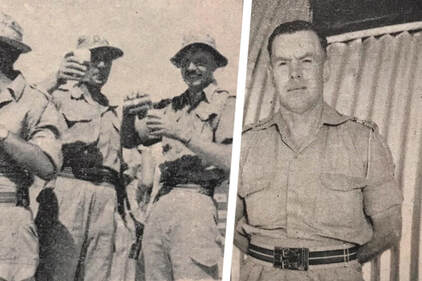
For years, we have been wondering what was the correct etiquette for the wearing of Regimental stable belts. The belts that were introduced in 1956 for wear with the 1st Battalion, were worn predominantly in Cyprus and were discontinued abruptly in 1960 by 1/1st East Anglian Regiment when one of their own colours was introduced for wear.
We had thought that they were originally worn with the buckles at the front, then moved to the side. This appeared to have been born out by conversations with former Suffolk Officers who said that the first CO in Cyprus, Lieutenant-Colonel 'Tiny' Heal disliked wearing the belt on any occasion as he felt it was a ridiculous item of uniform. 'Tiny' who was a man of imposing stature, was over six feet tall and 18 stone of solid muscle. He had played rugby with the All Blacks in 1936 at Plymouth, as a gesture of appreciation for when his father commanded the South African Brigade at Delville Wood in 1916 and was a good all-round athlete.
After command of the Battalion passed to Lieutenant-Colonel W.S. Bevan, the belt buckles appear to have been moved back from the side to the front. 'Bertie' Bevan was himself a man of grand stature and too disliked wearing the belt, but photographs do survive of him wearing a belt with the buckles at the front. The above photo left, taken in 1957 shows the belt being worn with the at the side. Naturally, we're all now a confused, so if anyone can shed any light on the matter, please do help us!
(Posted: 28/11/2019)
We had thought that they were originally worn with the buckles at the front, then moved to the side. This appeared to have been born out by conversations with former Suffolk Officers who said that the first CO in Cyprus, Lieutenant-Colonel 'Tiny' Heal disliked wearing the belt on any occasion as he felt it was a ridiculous item of uniform. 'Tiny' who was a man of imposing stature, was over six feet tall and 18 stone of solid muscle. He had played rugby with the All Blacks in 1936 at Plymouth, as a gesture of appreciation for when his father commanded the South African Brigade at Delville Wood in 1916 and was a good all-round athlete.
After command of the Battalion passed to Lieutenant-Colonel W.S. Bevan, the belt buckles appear to have been moved back from the side to the front. 'Bertie' Bevan was himself a man of grand stature and too disliked wearing the belt, but photographs do survive of him wearing a belt with the buckles at the front. The above photo left, taken in 1957 shows the belt being worn with the at the side. Naturally, we're all now a confused, so if anyone can shed any light on the matter, please do help us!
(Posted: 28/11/2019)
"Timeo Danaos et dona ferentes"
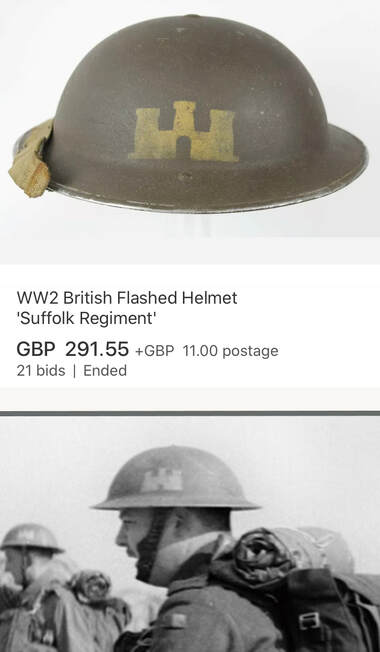
To Suffolk Regiment collectors, the phrase "beware the Greek bearing gifts" is one that is feared. As the world of military collectibles becomes ever more popular, so the rise of fakes and forgeries becomes more prevalent.
Recently we couldn't believe our luck when what purported to be an original Second World War example of a steel helmet belonging to a member of the 7th Battalion was offered for sale on eBay.
The helmet bore to the left hand brim, the three current yellow castle unique to them (and to the 8th Battalion). However, upon studying the photographs of the listing, we became a little unsure as to the genuineness of the piece and indeed, we soon became convinced that it was a fake. It was a spirited effort by someone who had clearly done their homework well, but it was lacking the detail of an original. A quick study of the surviving Movietone news of the 7th Battalion in training at Sandbanks in Dorset in 1941, and photographs of the 8th Battalion training in Epping Forest in 1942, convinced us that it was indeed a forgery.
The castellations of the stylised 'Gibraltar' Castle were too shallow and the castle was just not tall enough. It should have been closer to a style of castle worn in felt on the pugarree of the Foreign Service Helmet, rather than the cruder stencil that was applied. The listing passed, but we were shocked to discover when we looked again, that it had sold for an astounding £291.55.
We hope that the new owner is happy with their purchase, but we're also angry that this sort of thing continues to happen. Just this year, a fine early raw-edged Great War helmet with a 'sweated' Suffolk Regiment badge on the front was offered for sale. This example also are to the left hand side, a spade; the divisional symbol of the 12th Division - also pointing to this purporting to be a helmet worn by a member of the 7th Battalion.
If you're in any doubt about such things, do please contact us. We're keen to ensure that unsuspecting parties are not caught out by this sort of cunning and very clever forgery.
(Posted: 17/11/2019)
Recently we couldn't believe our luck when what purported to be an original Second World War example of a steel helmet belonging to a member of the 7th Battalion was offered for sale on eBay.
The helmet bore to the left hand brim, the three current yellow castle unique to them (and to the 8th Battalion). However, upon studying the photographs of the listing, we became a little unsure as to the genuineness of the piece and indeed, we soon became convinced that it was a fake. It was a spirited effort by someone who had clearly done their homework well, but it was lacking the detail of an original. A quick study of the surviving Movietone news of the 7th Battalion in training at Sandbanks in Dorset in 1941, and photographs of the 8th Battalion training in Epping Forest in 1942, convinced us that it was indeed a forgery.
The castellations of the stylised 'Gibraltar' Castle were too shallow and the castle was just not tall enough. It should have been closer to a style of castle worn in felt on the pugarree of the Foreign Service Helmet, rather than the cruder stencil that was applied. The listing passed, but we were shocked to discover when we looked again, that it had sold for an astounding £291.55.
We hope that the new owner is happy with their purchase, but we're also angry that this sort of thing continues to happen. Just this year, a fine early raw-edged Great War helmet with a 'sweated' Suffolk Regiment badge on the front was offered for sale. This example also are to the left hand side, a spade; the divisional symbol of the 12th Division - also pointing to this purporting to be a helmet worn by a member of the 7th Battalion.
If you're in any doubt about such things, do please contact us. We're keen to ensure that unsuspecting parties are not caught out by this sort of cunning and very clever forgery.
(Posted: 17/11/2019)
Remember
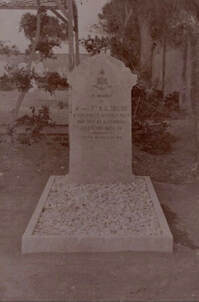
Remember today, all those who since the raising of the Regiment in 1685, have in many lands, given their lives for their country.
Lest We Forget.
(Posted: 11/11/2019)
Lest We Forget.
(Posted: 11/11/2019)
Major E.G.W. 'Gordon' Browne 1916-2019
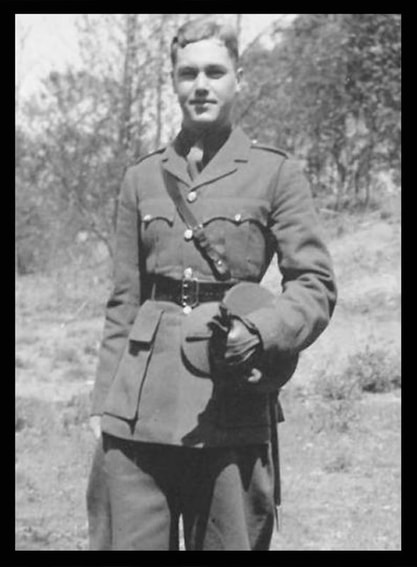
It was with sadness that we hear of the passing of Major E.G.W. Browne, who served with both 1st and 2nd Suffolk during the last war, and was we believe, the Regiment's last pre-war commissioned Sandhurst officer.
Edward Gordon Walker Browne was born at Tamil in southern India in 1916. He was sent home by his father to be educated at Cheltenham College and then into the Army. He passed out from the Royal Military Academy Sandhurst 1936 and was commissioned into the Suffolk Regiment.
Browne joined the 1st Battalion in Malta in November 1937 and was promoted to Lieutenant the following year. In October 1939, he went with the 1st Battalion to France as part of the B.E.F.
During the retreat from Dunkirk, he commanded a platoon of ‘B’ Company, when their commanding officer had been wounded near Furnes. He eventually found himself on a small beach just north of Dunkirk. Having waded out to a small boat, he managed to get 23 men to a destroyer and then onwards to England.
Safely back in England, Browne was promoted to Captain and sent away to the Staff College at Camberley. Having passed the course with flying colours, became a Brigade Major in a Division in Northern Ireland.
Eighteen months later, he was posted to Burma to join the 2nd Battalion, but upon arrival he was “volunteered” to join the newly-formed ‘Chindits’. He was not destined to remain with them for long and soon he was with the 2nd Battalion in India shortly before they were sent to fight the Japanese in the Arakan campaign.
Remaining with the 2nd Battalion in India after the war, he became the Battalion Intelligence Officer and later in Lahore, its Second-in-Command.
Browne ‘retired’ from the army in 1950 and immediately joined MI5 as an intelligence officer, later becoming it Deputy Head at the time of Kim Philby’s defection. Awarded a C.B.E in 1976, he moving back to the family house at West Malling in Sussex, where he remained active into his old age. Sprightly, he still played squash and tennis until he was 80, but he sadly outlived both his wife Molly, to whom he had been married since 1939, and his eldest son, Christopher, who had been a diplomat. In the last six weeks of his life, he moved into the Royal Star and Garter nursing home, before he died peacefully early in October.
'Gordon' Browne represents another chapter of our Regimental story which has now passed silently into history.
(Posted 01/11/2019)
With grateful thanks to The Times for the photograph of Browne.
Edward Gordon Walker Browne was born at Tamil in southern India in 1916. He was sent home by his father to be educated at Cheltenham College and then into the Army. He passed out from the Royal Military Academy Sandhurst 1936 and was commissioned into the Suffolk Regiment.
Browne joined the 1st Battalion in Malta in November 1937 and was promoted to Lieutenant the following year. In October 1939, he went with the 1st Battalion to France as part of the B.E.F.
During the retreat from Dunkirk, he commanded a platoon of ‘B’ Company, when their commanding officer had been wounded near Furnes. He eventually found himself on a small beach just north of Dunkirk. Having waded out to a small boat, he managed to get 23 men to a destroyer and then onwards to England.
Safely back in England, Browne was promoted to Captain and sent away to the Staff College at Camberley. Having passed the course with flying colours, became a Brigade Major in a Division in Northern Ireland.
Eighteen months later, he was posted to Burma to join the 2nd Battalion, but upon arrival he was “volunteered” to join the newly-formed ‘Chindits’. He was not destined to remain with them for long and soon he was with the 2nd Battalion in India shortly before they were sent to fight the Japanese in the Arakan campaign.
Remaining with the 2nd Battalion in India after the war, he became the Battalion Intelligence Officer and later in Lahore, its Second-in-Command.
Browne ‘retired’ from the army in 1950 and immediately joined MI5 as an intelligence officer, later becoming it Deputy Head at the time of Kim Philby’s defection. Awarded a C.B.E in 1976, he moving back to the family house at West Malling in Sussex, where he remained active into his old age. Sprightly, he still played squash and tennis until he was 80, but he sadly outlived both his wife Molly, to whom he had been married since 1939, and his eldest son, Christopher, who had been a diplomat. In the last six weeks of his life, he moved into the Royal Star and Garter nursing home, before he died peacefully early in October.
'Gordon' Browne represents another chapter of our Regimental story which has now passed silently into history.
(Posted 01/11/2019)
With grateful thanks to The Times for the photograph of Browne.
There Comes A Time In A Man's Life...
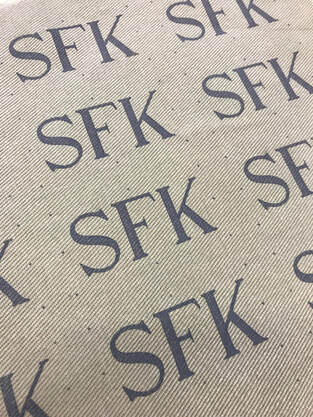
Sadly, there comes a time when a man life when those of us in the living history world, we gravitate from portraying the fighting infantryman, to the Home Guard.
Sadly with the passing of youth, the plausible portrayal of a young, fit fighting 'Tommy' becomes every more difficult, thus many of us in the evening of our 'dressing up' lives, naturally move to representing the more plausible Home Guardsman. The kit is virtually the same, but with different badges and only a different rifle and webbing is needed.
Thus today, we spent our lunchtime making the county patches for the Suffolk Home Guard, ready to embark on our last days in this hobby as a member of the real Dads Army. Copied from an original, these patches came out quite well we thought. Maybe there's a market in these?
(Posted: 20/10/2019)
Sadly with the passing of youth, the plausible portrayal of a young, fit fighting 'Tommy' becomes every more difficult, thus many of us in the evening of our 'dressing up' lives, naturally move to representing the more plausible Home Guardsman. The kit is virtually the same, but with different badges and only a different rifle and webbing is needed.
Thus today, we spent our lunchtime making the county patches for the Suffolk Home Guard, ready to embark on our last days in this hobby as a member of the real Dads Army. Copied from an original, these patches came out quite well we thought. Maybe there's a market in these?
(Posted: 20/10/2019)
In Search Of Captain Calder's Saviour
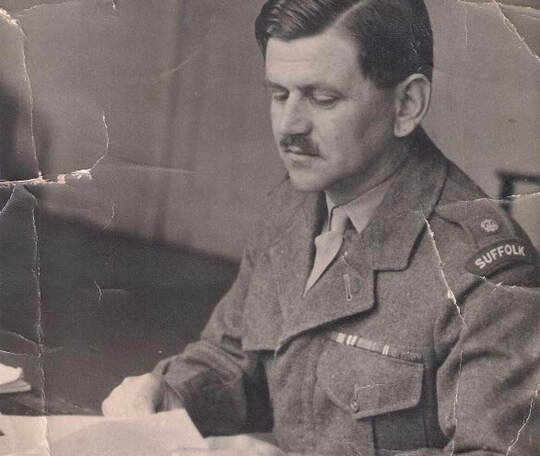
In the Dutch press over the past few weeks, there has been an appeal launched to try and find the brave Dutchman that saved the life of Captain ‘Johnny’ Calder at Overloon on 12 October 1944.
On 12th October, Captain Calder was Second-in-command of ‘B’ Company of 1/Suffolk. When the Company Commander went forward armed with a PIAT to try and disable a German tank, Captain Calder remained with the Company, dispersing the various platoons around the the nearby houses. As he darted from house to house, checking on the men, he was hit by mortar fire. As he lay wounded in the road, a Dutchman appeared from his house and dragged him inside, from where the Stretcher Bearers came forward to collect him.
Undoubedtly, this man saved his life, for it was the second time Captain Calder had been wounded in three months, however his wearabouts have remained a mystery. Captain Calder did return in the 1950s to find him and we believe the two men did met, but it would be nice to think that he may still be alive, or at least some his defendants.
Captain, later Major, Calder's son, followed him into the Army, as did his grandsons, and it is his son, Brigadier Tony Calder who is searching for any more information on this man. If you know of anymore details to this fascinating story, please do get in contact with us. The link to the original article is below (though it's written in Dutch!):
https://www.peelenmaasvenray.nl/nieuws/algemeen/76691/gezocht-redder-van-kapitein-john-calder-
(Posted: 15/10/2019)
On 12th October, Captain Calder was Second-in-command of ‘B’ Company of 1/Suffolk. When the Company Commander went forward armed with a PIAT to try and disable a German tank, Captain Calder remained with the Company, dispersing the various platoons around the the nearby houses. As he darted from house to house, checking on the men, he was hit by mortar fire. As he lay wounded in the road, a Dutchman appeared from his house and dragged him inside, from where the Stretcher Bearers came forward to collect him.
Undoubedtly, this man saved his life, for it was the second time Captain Calder had been wounded in three months, however his wearabouts have remained a mystery. Captain Calder did return in the 1950s to find him and we believe the two men did met, but it would be nice to think that he may still be alive, or at least some his defendants.
Captain, later Major, Calder's son, followed him into the Army, as did his grandsons, and it is his son, Brigadier Tony Calder who is searching for any more information on this man. If you know of anymore details to this fascinating story, please do get in contact with us. The link to the original article is below (though it's written in Dutch!):
https://www.peelenmaasvenray.nl/nieuws/algemeen/76691/gezocht-redder-van-kapitein-john-calder-
(Posted: 15/10/2019)
Suffolk Cemetery
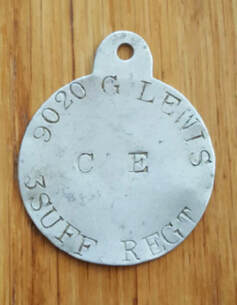
For those of you who know the Western Front, you will know that there are two Suffolk Cemeteries. One at Veerstraat south west of Belgium, and the other south of Artmetiers at Erquinghem.
The first cemetery was formed by the concentration of many graves from the early 1915 period when 1st Suffolk were in the front line here. Recently we saw for sale a medal and identity disc for Private Lewis who was a pre-war member of 3rd (Special Reserve) Battalion who joined the 1st Battalion in late 1914, when they returned from the Middle East where they had been on Foreign Service.
Lewis is buried in Suffolk Cemetery at Veerstraat, in his original grave. The area was bitterly fought over again in 1917, and many graves of 1915 graves were subsequently lost. Lewis must have had his disc removed when he was buried and returned to his family, for at that time, the army issued you with only one. A fascinating story that is worth of research, we hope its found a good home.
(Posted: 14/10/2019)
The first cemetery was formed by the concentration of many graves from the early 1915 period when 1st Suffolk were in the front line here. Recently we saw for sale a medal and identity disc for Private Lewis who was a pre-war member of 3rd (Special Reserve) Battalion who joined the 1st Battalion in late 1914, when they returned from the Middle East where they had been on Foreign Service.
Lewis is buried in Suffolk Cemetery at Veerstraat, in his original grave. The area was bitterly fought over again in 1917, and many graves of 1915 graves were subsequently lost. Lewis must have had his disc removed when he was buried and returned to his family, for at that time, the army issued you with only one. A fascinating story that is worth of research, we hope its found a good home.
(Posted: 14/10/2019)
The Liberator Returns
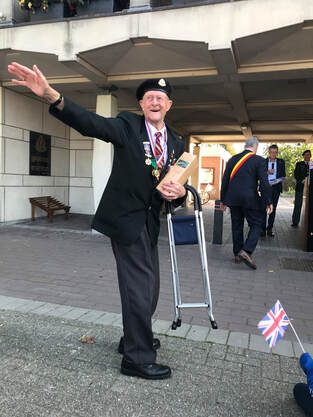
We're now back from a fantastic long weekend in Belgium and Holland following the actions of the 1st Battalion in 1944-45, but our primary aim was to take back one of our last surviving veterans to attend the commemorations at Hamont, which was liberated by 1/Suffolk on 20th September 1944.
We had intended to run a larger tour but sadly lack of interest prevented it going ahead, but on Minden Day, we meant Cecil Deller who served in 'A' Company, who want to go back. With it being the 75th anniversary of the battles at Arnhem, hotels were difficult to obtain, but after much effort we managed to find two rooms in Weert and a last minute ferry crossing so we were off!
Our good friends in Hamont were very pleased to see us, but in particularly Cecil, who was treated like royalty wherever we went. He laid a wreath on behalf of the Suffolk Regiment in Hamont, after which we attended the opening of their new exhibition in the museum at Achel.
The Suffolk Regiment's actions are still very much commemorated in Hamont and we hope to continue the relationship we have built with our friends there in the years to come.
(Posted: 23/09/2019)
We had intended to run a larger tour but sadly lack of interest prevented it going ahead, but on Minden Day, we meant Cecil Deller who served in 'A' Company, who want to go back. With it being the 75th anniversary of the battles at Arnhem, hotels were difficult to obtain, but after much effort we managed to find two rooms in Weert and a last minute ferry crossing so we were off!
Our good friends in Hamont were very pleased to see us, but in particularly Cecil, who was treated like royalty wherever we went. He laid a wreath on behalf of the Suffolk Regiment in Hamont, after which we attended the opening of their new exhibition in the museum at Achel.
The Suffolk Regiment's actions are still very much commemorated in Hamont and we hope to continue the relationship we have built with our friends there in the years to come.
(Posted: 23/09/2019)
Following In Their Footsteps...
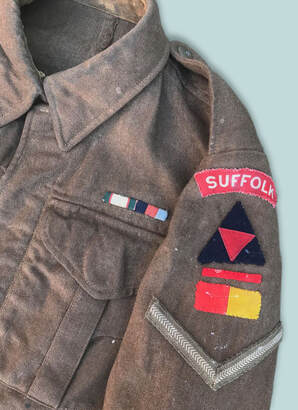
We'll shortly be going a little quiet as we are planning a mini battlefield tour to Holland and Belgium following in the footsteps of the 1st Battalion in 1944.
We are taking back one of our last surviving First Suffolk veterans to attend the ceremonies at Hamont and in Weert along with a few choice surviving artefacts from that period.
We'll try and keep you updated as far as possible via our Facebook page and there will be a full report in the next magazine, due out in November. Follow us on what we hope will be a great few days.
(Posted: 18/09/2019)
We are taking back one of our last surviving First Suffolk veterans to attend the ceremonies at Hamont and in Weert along with a few choice surviving artefacts from that period.
We'll try and keep you updated as far as possible via our Facebook page and there will be a full report in the next magazine, due out in November. Follow us on what we hope will be a great few days.
(Posted: 18/09/2019)
'Peace In Our Time' - Remembered Eighty Years On
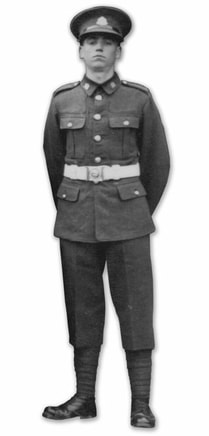
Eighty years ago today, the First Battalion were Paraded at South Raglan Barracks, Plymouth, to hear the broadcast of Prime Minister, Neville Chamberlain, as he announced that Great Britain was at war with Germany.
In the hushed and sombre silence, orders were given to pack away the militiamen's civilian clothes and have them sent home. Kit bags were issued for surplus kit to be packed and handed into stores, for a mobilisation order was expected within hours ordering the Battalion overseas for service.
In truth, it was to be a further six weeks before the Battalion departed for France as bart of a second British Expeditionary Force, but this time it was not into battle, but into a period of a 'phoney' war, with inactivity and and an expectation that this war would much the same as the last.
In Suffolk, the 4th Battalion were mobilised immediately and troops were sent by trust from Ipswich to guard the important and crucial 'RDF' radar station at Bawdsey Heath. The 5th Battalion had been mobilised too and were forming a perimeter guard around airfields at Stadishall and Wattisham.
In far away India, the 2nd Battalion were at play with the Battalion athletics and swimming competitions in full swing. A draft of men who had arrived from England in the past week, wore a new curious uniform known as 'battledress'.
So remember all those today, who on that first day of war stood ready to defend their country and to fight for the freedom of its inhabitants. Remember too, the countless others that join the Regiment in the six years of war that followed before their enemies were finally defeated.
(Posted: 03/09/2019)
In the hushed and sombre silence, orders were given to pack away the militiamen's civilian clothes and have them sent home. Kit bags were issued for surplus kit to be packed and handed into stores, for a mobilisation order was expected within hours ordering the Battalion overseas for service.
In truth, it was to be a further six weeks before the Battalion departed for France as bart of a second British Expeditionary Force, but this time it was not into battle, but into a period of a 'phoney' war, with inactivity and and an expectation that this war would much the same as the last.
In Suffolk, the 4th Battalion were mobilised immediately and troops were sent by trust from Ipswich to guard the important and crucial 'RDF' radar station at Bawdsey Heath. The 5th Battalion had been mobilised too and were forming a perimeter guard around airfields at Stadishall and Wattisham.
In far away India, the 2nd Battalion were at play with the Battalion athletics and swimming competitions in full swing. A draft of men who had arrived from England in the past week, wore a new curious uniform known as 'battledress'.
So remember all those today, who on that first day of war stood ready to defend their country and to fight for the freedom of its inhabitants. Remember too, the countless others that join the Regiment in the six years of war that followed before their enemies were finally defeated.
(Posted: 03/09/2019)
Remembering VJ Day
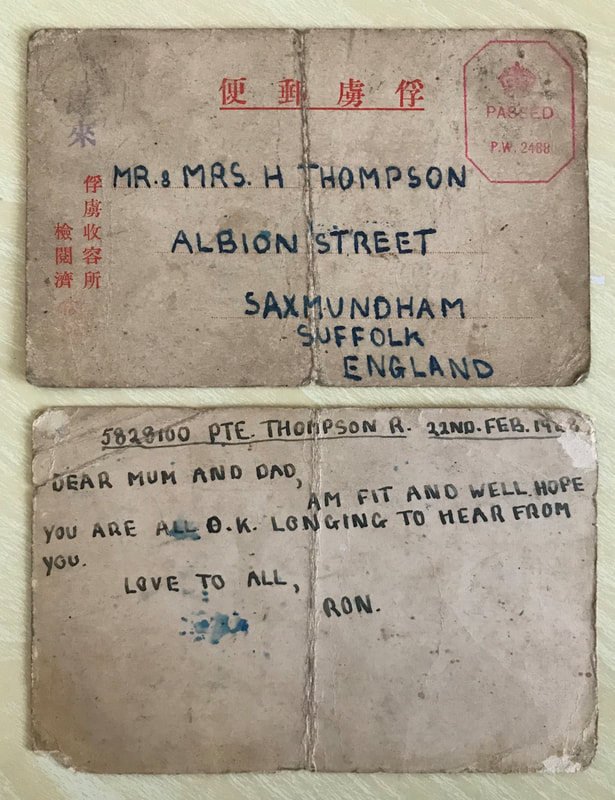
On the 74th anniversary of VJ Day, spare a thought for all those men of the various Battalions of the Suffolk and Cambridgeshire Regiment's who were fighting against, or being held in captivity by the Japanese.
For 4th and 5th Suffolk, they had been taken prisoner at Singapore in February 1942 and had already endured two and half years of brutal captivity at the ruthless hands of their Japanese captors. Their comrades in 1st and 2nd Cambridgeshire, suffered a similar fate.
Away in the jungles of the Arakan, and later at Imphal and Kohima, the 2nd Battalion were fighting them in the jungle and were slowly beating them back, but 75 years ago, there was still to be another 12 months of fighting before, the Japanese were finally beaten.
For those in captivity in the numerous camps in Thailand that spanned the every progressing Bangkok-Rangoon railway there was no let up in their savage treatment. Starved of food, medical provisions and clothing, men of the two Suffolk Battalions, like Private Ron Thompson from Saxmundham, received no news from home. His parents received only sporadic 'official' news of their son, and Ron in return, received just five postcards from home during his three and a half years of captivity.
So today, remember Ron and all his comrades, and never forget what they went through at the hands of an enemy who considered them nothing more than slave labour. As many perished as the railroad progressed, remember the words of the Kohima Epitaph that "For your tomorrow, we gave our today."
(Posted: 15/08/2019)
For 4th and 5th Suffolk, they had been taken prisoner at Singapore in February 1942 and had already endured two and half years of brutal captivity at the ruthless hands of their Japanese captors. Their comrades in 1st and 2nd Cambridgeshire, suffered a similar fate.
Away in the jungles of the Arakan, and later at Imphal and Kohima, the 2nd Battalion were fighting them in the jungle and were slowly beating them back, but 75 years ago, there was still to be another 12 months of fighting before, the Japanese were finally beaten.
For those in captivity in the numerous camps in Thailand that spanned the every progressing Bangkok-Rangoon railway there was no let up in their savage treatment. Starved of food, medical provisions and clothing, men of the two Suffolk Battalions, like Private Ron Thompson from Saxmundham, received no news from home. His parents received only sporadic 'official' news of their son, and Ron in return, received just five postcards from home during his three and a half years of captivity.
So today, remember Ron and all his comrades, and never forget what they went through at the hands of an enemy who considered them nothing more than slave labour. As many perished as the railroad progressed, remember the words of the Kohima Epitaph that "For your tomorrow, we gave our today."
(Posted: 15/08/2019)
Traditions Continued
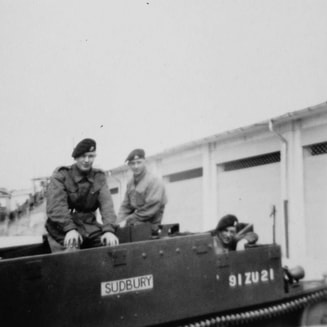
One of the great highlights of Minden Day, was the chance to see the album of a Suffolk National Serviceman who served in Malaya, Trieste and in Germany.
One of his photographs showed two of his chums in a Universal or "Bren Gun" carrier, outside the MT shed at Harding Barracks, Wuppertal but what was interesting to us was that the carrier bore the name of the Suffolk town 'Sudbury'
We know that during the war in Northwest Europe, the 1st Battalion adopted Suffolk place names for the Carrier Platoon, whilst the Mortar Platoon had Regimental Battle Honours. Examples known during the war include 'Felixstowe' 'Framlingham' and 'Newmarket' but we had no idea that the tradition carried on in the post-war years.
We knew that the tradition of Battle Honours was continued into service with the Battalion in Malaya, with scouts cars being named after numerous Honours, but not that tradition continued with Suffolk place names. Do you know of any more examples? if so please get in touch with us.
(Posted: 13/08/2019)
One of his photographs showed two of his chums in a Universal or "Bren Gun" carrier, outside the MT shed at Harding Barracks, Wuppertal but what was interesting to us was that the carrier bore the name of the Suffolk town 'Sudbury'
We know that during the war in Northwest Europe, the 1st Battalion adopted Suffolk place names for the Carrier Platoon, whilst the Mortar Platoon had Regimental Battle Honours. Examples known during the war include 'Felixstowe' 'Framlingham' and 'Newmarket' but we had no idea that the tradition carried on in the post-war years.
We knew that the tradition of Battle Honours was continued into service with the Battalion in Malaya, with scouts cars being named after numerous Honours, but not that tradition continued with Suffolk place names. Do you know of any more examples? if so please get in touch with us.
(Posted: 13/08/2019)
Another Great Day
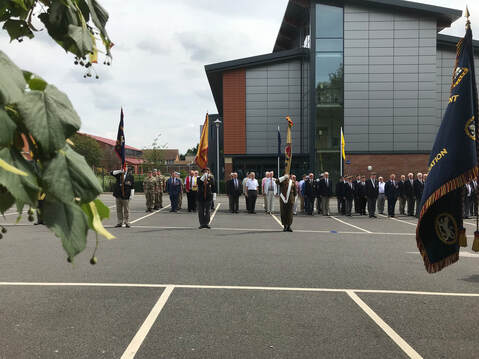
In glorious weather, today the Gibraltar Barracks at Bury St. Edmunds, the massed ranks of the Suffolk Regiment Old Comrades Association gathered for their annual reunion. Though ranks were down on past years, they were up on last year, most probably due to the good weather.
A change of organisational committee saw buoyant optimism in the air with many of a younger generation attending.
The Friends had a stand as usual and renewals were up on last year. New members were few, but enquiries on family history and photographs of family members flowed in. We were busy all day and by mid-afternoon, the pace had slackened and the day gradually wound down.
Next year, will we hope to continue that trend and that we will see more old comrades in attendance. Well done to the team and we very much look forward to next years event.
(Posted: 04/08/2019)
A change of organisational committee saw buoyant optimism in the air with many of a younger generation attending.
The Friends had a stand as usual and renewals were up on last year. New members were few, but enquiries on family history and photographs of family members flowed in. We were busy all day and by mid-afternoon, the pace had slackened and the day gradually wound down.
Next year, will we hope to continue that trend and that we will see more old comrades in attendance. Well done to the team and we very much look forward to next years event.
(Posted: 04/08/2019)
Happy Minden Day!
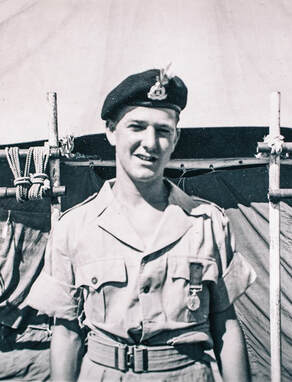
A very happy Minden Day to you all.
260 years after the Suffolk Regiment won its most proudest Battle Honour, today, their descendants, still commemorate that day.
As 1/Royal Anglian Regiment celebrate the day at their barracks at Woolwich, where many will be presented with medals for service on operations overseas, let us remember too that sixty years ago this month, at Iselohn in Germany, the Suffolk Regiment was amalgamated with the Royal Norfolk Regiment.
But although that was the death of the 'Old Twelfth' on paper, their former members live on. In a few days, they will converge from all across the county to return to their old depot site at Bury St. Edmunds, to relive old campaigns and to meet old comrades.
Though their ranks are gently demising, the Regiment is by no means dead. The Friends today, enter their eleventh year of existence, firm on our initial ideals to preserve the history and traditions of the Suffolk Regiment. Join us and help keep that ideal going.
(Posted: 01/08/2019)
260 years after the Suffolk Regiment won its most proudest Battle Honour, today, their descendants, still commemorate that day.
As 1/Royal Anglian Regiment celebrate the day at their barracks at Woolwich, where many will be presented with medals for service on operations overseas, let us remember too that sixty years ago this month, at Iselohn in Germany, the Suffolk Regiment was amalgamated with the Royal Norfolk Regiment.
But although that was the death of the 'Old Twelfth' on paper, their former members live on. In a few days, they will converge from all across the county to return to their old depot site at Bury St. Edmunds, to relive old campaigns and to meet old comrades.
Though their ranks are gently demising, the Regiment is by no means dead. The Friends today, enter their eleventh year of existence, firm on our initial ideals to preserve the history and traditions of the Suffolk Regiment. Join us and help keep that ideal going.
(Posted: 01/08/2019)
The "Grimmest Mile In France"
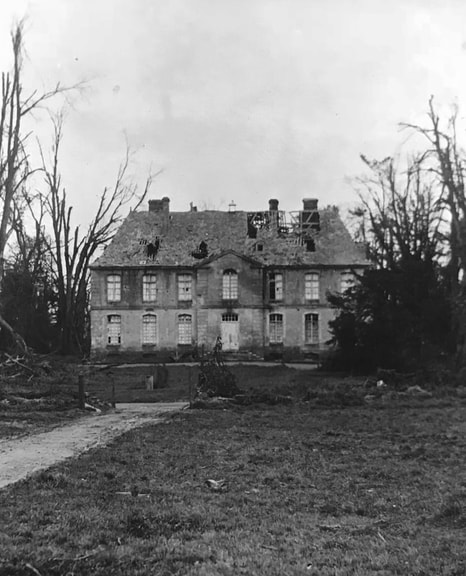
Remember the 161 men of the 1st Battalion, The Suffolk Regiment, who were killed, wounded and missing in the battle to take the Chateau de la Londe near Caen, 75 years ago today.
In a bitter, confused and ferocious battle, ‘B’ and ‘C’ companies took the largest amount of casualties as they advanced to take the Chateau and its grounds. Continual enemy mortar barrages and enemy armour caused heavy casualties to those who made it to the objective and in moving forward to support them, ‘D’ Company also suffered heavy casualties including its commanding officer, Major Papillon.
Both ‘B’ and ‘C’ companies commanders, Major’s McCaffrey, and Boycott were wounded in the advance and McCaffrey’s second-in-command, Captain Archdall was killed. In each company, two of the three Platoon commanders were wounded and one died later of his injuries.
Of the thirty seven men killed that day, a large number were ex-2nd Battalion soldiers who already had seen pre-war service in India, and wartime service in Burma.
Described as the “Grimmest mile in France” it was the single largest loss of life that the Battalion incurred during the entire NW Europe campaign.
Spare a thought today for those who fell there and as the inscription on the original cross erected at the head of ‘Suffolk cemetery’ noted “They will never be forgotten”
(Posted: 28/06/2019)
In a bitter, confused and ferocious battle, ‘B’ and ‘C’ companies took the largest amount of casualties as they advanced to take the Chateau and its grounds. Continual enemy mortar barrages and enemy armour caused heavy casualties to those who made it to the objective and in moving forward to support them, ‘D’ Company also suffered heavy casualties including its commanding officer, Major Papillon.
Both ‘B’ and ‘C’ companies commanders, Major’s McCaffrey, and Boycott were wounded in the advance and McCaffrey’s second-in-command, Captain Archdall was killed. In each company, two of the three Platoon commanders were wounded and one died later of his injuries.
Of the thirty seven men killed that day, a large number were ex-2nd Battalion soldiers who already had seen pre-war service in India, and wartime service in Burma.
Described as the “Grimmest mile in France” it was the single largest loss of life that the Battalion incurred during the entire NW Europe campaign.
Spare a thought today for those who fell there and as the inscription on the original cross erected at the head of ‘Suffolk cemetery’ noted “They will never be forgotten”
(Posted: 28/06/2019)
Remembering 'Isaac'
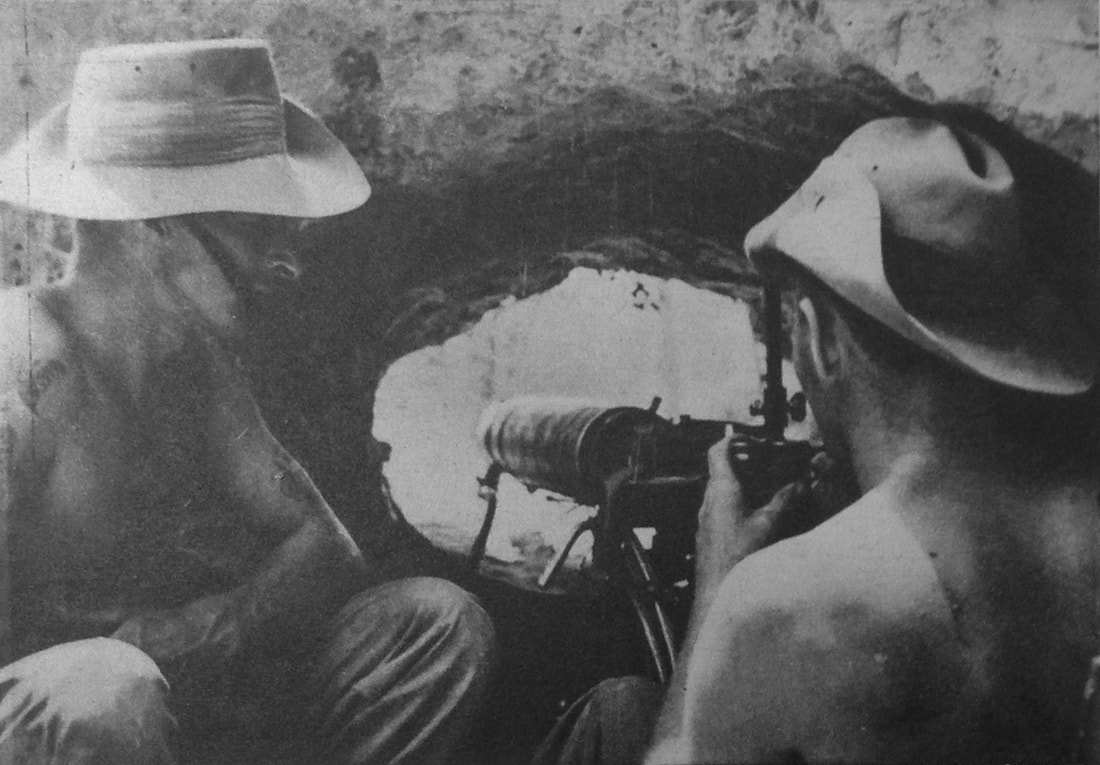
As the attention of the past few days has focused on the invasion of Europe in 1944, let us not forget that 75 years ago today on the other side of the world, the men of 2nd Suffolk were ending a three-day battle to take the Japanese hilltop fortification known as ‘Isaac’, just north of the Indian town of Imphal.
Between the 6th and 8th June 1944, 2nd Suffolk were fighting a bitter hand-to-hand battle against the Japanese in their well constructed positions.
After active patrolling, a thrust on 7th June by ‘C’ Company gained entry into the position but armoured support was trapped by a well-concealed anti-tank ditch. As ‘A’ and ‘D’ Companies relieved ‘C’ Company, a fresh attack went in the following day, supported by an air strike. With much determination, ‘A’ and ‘D’ Companies pressed-on and late on the 8th June, finally overcame the position with much bitter fighting.
In many respects, the action was similar to that which the 1st Battalion fought on D-Day to take the bunker complex ‘Hillman’. Both fortifications were in commanding positions. Both were more heavily defended than the intelligence the Battalion Commanders were given beforehand, led them to believe. Both were impassible to armour without much clearance. Both relied on the Infantry to clear them.
So, spare a thought today for those in the ‘Battalion in the East’ who were fighting a war in the jungle every bit as ferocious as that in Europe, with the same tenacity for which the Suffolk solider is famed. Their Divisional Commander congratulated them for their efforts stating that ‘your success was due to your determination to succeed’.
(Posted: 09/06/2019)
Between the 6th and 8th June 1944, 2nd Suffolk were fighting a bitter hand-to-hand battle against the Japanese in their well constructed positions.
After active patrolling, a thrust on 7th June by ‘C’ Company gained entry into the position but armoured support was trapped by a well-concealed anti-tank ditch. As ‘A’ and ‘D’ Companies relieved ‘C’ Company, a fresh attack went in the following day, supported by an air strike. With much determination, ‘A’ and ‘D’ Companies pressed-on and late on the 8th June, finally overcame the position with much bitter fighting.
In many respects, the action was similar to that which the 1st Battalion fought on D-Day to take the bunker complex ‘Hillman’. Both fortifications were in commanding positions. Both were more heavily defended than the intelligence the Battalion Commanders were given beforehand, led them to believe. Both were impassible to armour without much clearance. Both relied on the Infantry to clear them.
So, spare a thought today for those in the ‘Battalion in the East’ who were fighting a war in the jungle every bit as ferocious as that in Europe, with the same tenacity for which the Suffolk solider is famed. Their Divisional Commander congratulated them for their efforts stating that ‘your success was due to your determination to succeed’.
(Posted: 09/06/2019)
The Heroes Return.
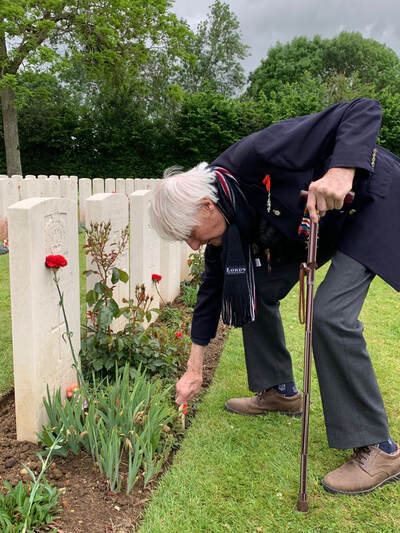
As the Queen and grateful nation paused yesterday to remember those who landed on D-Day 75 years ago, today in Normandy, the very last survivors of that momentous day have made return journey to France to attend the commemorations at the Hillman Bunker.
Ken Wright, a section sniper from 15 Platoon, C Company, made a pilgrimage to Colleville-Montgomery, together with Ken Mayhew, who commanded the Carrier Platoon that day.
As Ken Wright returned to the beaches to find the spot where he came ashore, Ken Mayhew went to Hermanville Cemetery to lay a cross at the grave of his fellow officer, Philip Papillon, who was killed on the 28th June 1944.
In this, perhaps the last year that a sizeable contingent of Allied veterans would return to their former battlefields, let us remember however that D-Day was but the first day in an eleven month campaign that saw the 1st Battalion fight across northern Europe before their enemy were finally beaten.
Though they may now be short in number, their deeds in that campaign are in no way forgotten.
(Posted: 06/06/2019)
Ken Wright, a section sniper from 15 Platoon, C Company, made a pilgrimage to Colleville-Montgomery, together with Ken Mayhew, who commanded the Carrier Platoon that day.
As Ken Wright returned to the beaches to find the spot where he came ashore, Ken Mayhew went to Hermanville Cemetery to lay a cross at the grave of his fellow officer, Philip Papillon, who was killed on the 28th June 1944.
In this, perhaps the last year that a sizeable contingent of Allied veterans would return to their former battlefields, let us remember however that D-Day was but the first day in an eleven month campaign that saw the 1st Battalion fight across northern Europe before their enemy were finally beaten.
Though they may now be short in number, their deeds in that campaign are in no way forgotten.
(Posted: 06/06/2019)
Remembering D-Day: 75 Years On
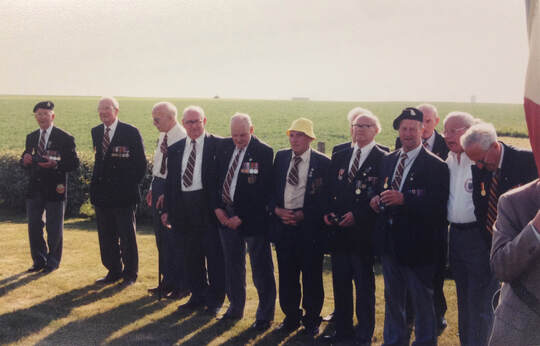
As commemorations to celebrate and commemorate the 75th anniversary of the D-Day landings begin across Britain and in France, we have been getting a little bit nostalgic about past reunions and members of the 1st Battalion who are now sadly, no longer with us.
As the living face of that generation fades gently away, we were reminded of the reunions in Normandy in which we participated in 1994, 1999, 2004 and 2009. We're recalling with much affection the many 'Vin d'Honneur' held in Colleville by our good chums 'Les Amis du Suffolk Regiment' and of all the characters that they contained. Of a slightly tipsy Lieutenant Frank Matthews singing the Marseilles. Of Major Hugh Merriam raising an eyebrow to 'Titch' Hunter who had had a glass too many. Of Bill Jacobs cursing at the French photographer at the Chateau de la Londe who accidentally knocked him into a hedge, and of John Fenn describing in detail the loading procedure of mortar bombs into his carrier as we sat in the sunshine at Banneville.
Good times that will never be repeated, being in the presence of ones personal heroes, but great memories that will last forever.
(Posted: 04/06/2019)
As the living face of that generation fades gently away, we were reminded of the reunions in Normandy in which we participated in 1994, 1999, 2004 and 2009. We're recalling with much affection the many 'Vin d'Honneur' held in Colleville by our good chums 'Les Amis du Suffolk Regiment' and of all the characters that they contained. Of a slightly tipsy Lieutenant Frank Matthews singing the Marseilles. Of Major Hugh Merriam raising an eyebrow to 'Titch' Hunter who had had a glass too many. Of Bill Jacobs cursing at the French photographer at the Chateau de la Londe who accidentally knocked him into a hedge, and of John Fenn describing in detail the loading procedure of mortar bombs into his carrier as we sat in the sunshine at Banneville.
Good times that will never be repeated, being in the presence of ones personal heroes, but great memories that will last forever.
(Posted: 04/06/2019)
Very Pleased With The Result
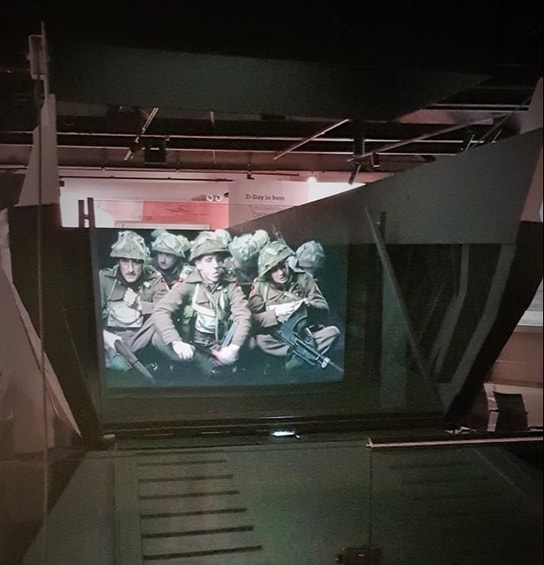
Last year, we helped in the production of a short film being made by the D-Day Museum In Portsmouth.
The film, featured a Section of men from 1/Suffolk in their landing craft as it approached the Normandy beaches on D-Day. The Friends assisted in getting the correct insignia applied to their battledress blouses and the remainder of their uniforms and equipment was supplied by our good friends at Khaki Devil.
Recently on a work visit to Portsmouth, we decided to call in and take a look at the finished result. The image here show the film being played in the museum. It is very cleverly projected onto a screen in an original LCI (Landing Craft Infantry).
In the film, everyone looks so well, contrary to the majority of the surviving accounts of the Battalion's run-in to the landing beaches where everyone pretty much unanimously stated that everyone was being, or had been sick, except Major Boycott, commanding 'C' Company who recalled later that "being sick might have been badly misconstrued!"
(Posted: 17/05/2019)
The film, featured a Section of men from 1/Suffolk in their landing craft as it approached the Normandy beaches on D-Day. The Friends assisted in getting the correct insignia applied to their battledress blouses and the remainder of their uniforms and equipment was supplied by our good friends at Khaki Devil.
Recently on a work visit to Portsmouth, we decided to call in and take a look at the finished result. The image here show the film being played in the museum. It is very cleverly projected onto a screen in an original LCI (Landing Craft Infantry).
In the film, everyone looks so well, contrary to the majority of the surviving accounts of the Battalion's run-in to the landing beaches where everyone pretty much unanimously stated that everyone was being, or had been sick, except Major Boycott, commanding 'C' Company who recalled later that "being sick might have been badly misconstrued!"
(Posted: 17/05/2019)
The Home Guard
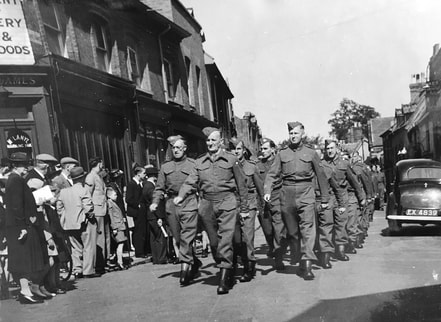
It's funny, but here at the Friends we never seem to mention the men of the Home Guard not nearly enough as we should do.
The men of the various Suffolk Battalion's proudly wore the Regiment's Badge and stood alone throughout the early stages of the war, as Britains first line of defence.
Recently on Facebook, the photograph here surfaced. It shows men of the 1st (Beccles) Battalion, Suffolk Home Guard machining down Smallgate Street in the town. They wear the woollen battledress that replaced the old Denim overalls they were issued in 1940, but have no belts or weapons. This might have been taken in 1944 at their Stand Down Parade as no gas masks are worn either.
Any further information as to the photograph would be very much appreciated.
(Posted: 12/05/2019)
The men of the various Suffolk Battalion's proudly wore the Regiment's Badge and stood alone throughout the early stages of the war, as Britains first line of defence.
Recently on Facebook, the photograph here surfaced. It shows men of the 1st (Beccles) Battalion, Suffolk Home Guard machining down Smallgate Street in the town. They wear the woollen battledress that replaced the old Denim overalls they were issued in 1940, but have no belts or weapons. This might have been taken in 1944 at their Stand Down Parade as no gas masks are worn either.
Any further information as to the photograph would be very much appreciated.
(Posted: 12/05/2019)
Wot...No Daffodil Sunday!
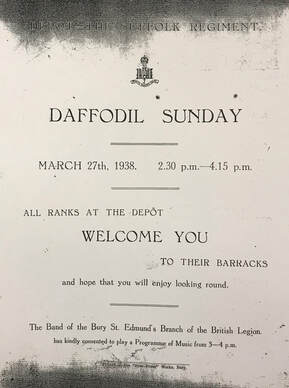
With the daffodils in the back garden bursting into bloom, it suddenly dawned upon us that we'd not received any word from the Regimental museum that "Daffodil Sunday" was being held this year.
Traditionally the open day of the barracks, where the public me to see how the Regiment functioned, with was usually the last weekend in March when the age-old daffodils burst into colour across the Depot site.
Well, anyway don't delay, get over to the Regimental Museum and explore its treasures - and walk around the old Depot site and marvel at the 80+ year old daffodils that burst forth into bloom each year.
(Posted: 02/04/2019)
Traditionally the open day of the barracks, where the public me to see how the Regiment functioned, with was usually the last weekend in March when the age-old daffodils burst into colour across the Depot site.
Well, anyway don't delay, get over to the Regimental Museum and explore its treasures - and walk around the old Depot site and marvel at the 80+ year old daffodils that burst forth into bloom each year.
(Posted: 02/04/2019)
Unique 'Antiques Roadshow' Find
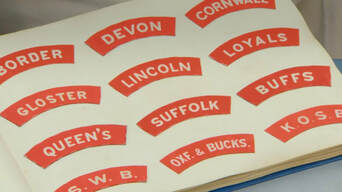
A colleague at work recently drew to our attention, an interesting find on the BBC Antiques Roadshow in the form of a unique pattern book of Second World War printed badges, amongst which was a Suffolk Regiment shoulder title.
The programme, transmitted a couple of weeks back, featured a pair of pattern books produced by the firm of "Calico Printers" from Accrington, who held one of several contracts during the Second World War for the manufacture of printed insignia for the British Military. The two books that were displayed together with a number of Civil Defence printed armbands, contain hundreds of examples of printed insignia manufactured for Army between 1941 and 1945. Printed insignia was widely introduced in 1942 to save on the manufacture of costly, intricate embroidered badges. Shoulder titles for the infantry were standardised to a set design of white on scarlet, with exceptions for Corps and a few rifle regiments.
As the expert leafed through the two books that had been brought along, one page displayed these shoulder titles, in the centre of which was a printed 'Suffolk' title. It is most likely that the company kept an example of each badge they manufactured and late compiled the books as a record of their wartime manufacturing. A unique record we would think, and very valuable for averaging £10 per badge, the collection was valued at £10,000!
(Posted: 28/03/2019)
The programme, transmitted a couple of weeks back, featured a pair of pattern books produced by the firm of "Calico Printers" from Accrington, who held one of several contracts during the Second World War for the manufacture of printed insignia for the British Military. The two books that were displayed together with a number of Civil Defence printed armbands, contain hundreds of examples of printed insignia manufactured for Army between 1941 and 1945. Printed insignia was widely introduced in 1942 to save on the manufacture of costly, intricate embroidered badges. Shoulder titles for the infantry were standardised to a set design of white on scarlet, with exceptions for Corps and a few rifle regiments.
As the expert leafed through the two books that had been brought along, one page displayed these shoulder titles, in the centre of which was a printed 'Suffolk' title. It is most likely that the company kept an example of each badge they manufactured and late compiled the books as a record of their wartime manufacturing. A unique record we would think, and very valuable for averaging £10 per badge, the collection was valued at £10,000!
(Posted: 28/03/2019)
The Demise Of The Regimental Tie
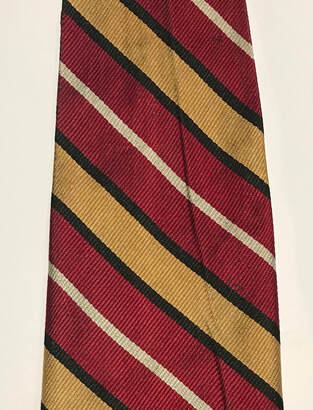
It was not many years ago that the distinctive Suffolk Regiment tie was a regular sight in town's across the county. Now sadly, it is seen less than the Loch Ness Monster.
A sad fact that the living face of the Regiment is diminishing fast, it now cannot be purchased in many of the outlets that used to stock it. Demand being of course, not what it used to be. The idea of Captain and Adjutant Shadwell, and the Commanding Officer, Colonel O'Grady-Haly, its creation in the late 1880s, was one of the first 'regimental ties' in existence.
It's colours represented scarlet of the infantry tunics, old gold of its original facings, white of its facings during the Cardwell Reforms of the Army, and a black stripe in mourning for the death of General Wolfe, the Regiment's most famous Ensign.
As the Royal Anglian Shop have stopped stocking it, and 'Smart Turnout' have ceased producing it, procurement of examples will become more difficult than ever. Only one manufacturer in the USA makes them in silk and in the UK, only Polyester ties are available.
As it is now only 'officially' worn by the Old Comrades Association, the Suffolk Army Cadet Force and men on 'B' (Suffolk) Company, 1 Royal Anglian, it's wear might soon slip into history. Once described as the 'most hideous regimental tie', let's hope that the Friends can keep it in the public eye for just a little longer.
(Posted: 11/03/2019)
A sad fact that the living face of the Regiment is diminishing fast, it now cannot be purchased in many of the outlets that used to stock it. Demand being of course, not what it used to be. The idea of Captain and Adjutant Shadwell, and the Commanding Officer, Colonel O'Grady-Haly, its creation in the late 1880s, was one of the first 'regimental ties' in existence.
It's colours represented scarlet of the infantry tunics, old gold of its original facings, white of its facings during the Cardwell Reforms of the Army, and a black stripe in mourning for the death of General Wolfe, the Regiment's most famous Ensign.
As the Royal Anglian Shop have stopped stocking it, and 'Smart Turnout' have ceased producing it, procurement of examples will become more difficult than ever. Only one manufacturer in the USA makes them in silk and in the UK, only Polyester ties are available.
As it is now only 'officially' worn by the Old Comrades Association, the Suffolk Army Cadet Force and men on 'B' (Suffolk) Company, 1 Royal Anglian, it's wear might soon slip into history. Once described as the 'most hideous regimental tie', let's hope that the Friends can keep it in the public eye for just a little longer.
(Posted: 11/03/2019)
For The Man Who Has Everything
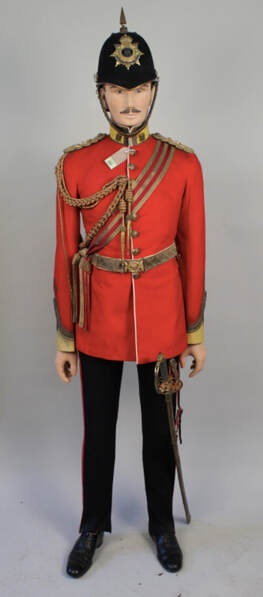
For the man who has everything, a complete Brigadier's uniform of the Suffolk Regiment is being auctioned next month at Durrant's auction house in Beccles.
The figure is complete from top to toe, with officers Home service Helmet, scarlet jacket with yellow facings, Crimson and gold aguilletttes and sash. General List officer's pattern belt with Royal Crest, and George Boots, just as an Suffolk Officer would have appeared from the Boer War onwards.
This ensemble was still being worn as late as 1935 when the Regiment celebrated the 250th anniversary of its creation (Colonel Parry-Crooke was certainly also wearing a similar ensemble at that time). It is not believed that all the elements belong to the same person, but the previous owner has gone to considerable lengths to ensure that the helmet plate, buttons and collar dogs are all correct for the period with three turrets to the Castle.
The auctioneers estimate is £1200-1500 which considering the value of all the elements involved is quite realistic. It has come from a local Suffolk private museum that is now being disposed off. The opening bid is £720 so get you bids in early fro the auction which starts on 16th March.
For more information, please visit www.durrants.com
(Posted: 23/02/2019)
The figure is complete from top to toe, with officers Home service Helmet, scarlet jacket with yellow facings, Crimson and gold aguilletttes and sash. General List officer's pattern belt with Royal Crest, and George Boots, just as an Suffolk Officer would have appeared from the Boer War onwards.
This ensemble was still being worn as late as 1935 when the Regiment celebrated the 250th anniversary of its creation (Colonel Parry-Crooke was certainly also wearing a similar ensemble at that time). It is not believed that all the elements belong to the same person, but the previous owner has gone to considerable lengths to ensure that the helmet plate, buttons and collar dogs are all correct for the period with three turrets to the Castle.
The auctioneers estimate is £1200-1500 which considering the value of all the elements involved is quite realistic. It has come from a local Suffolk private museum that is now being disposed off. The opening bid is £720 so get you bids in early fro the auction which starts on 16th March.
For more information, please visit www.durrants.com
(Posted: 23/02/2019)
A Beautiful Gift
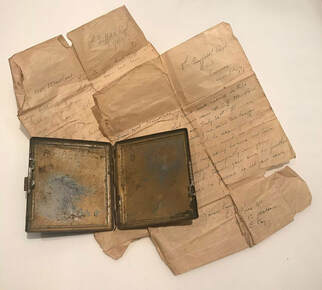
A lovely gift to the Friends arrived today in the form of a cigarette case and two letters written by Lieutenant Rae of 12 Platoon, C Company, 8th Suffolk, to the father of Private Maskell who was wounded by shell fire on 31st July 1917 when the Battalion attacked from ‘Stirling Castle’ towards ‘Glencorse Wood’ on the opening day of the Third Battle of Ypres.
The first letter stated he was killed in action, but the second, written just two days later, revealed that he had since been found at the Regimental Aid Post with shell wounds to the legs and head. The battered cigarette case inscribed ‘P Maskell’ was carried by him on the day he was wounded.
We are truly grateful to our generous benefactor and we are now researching the story of Percy Maskell and his service with the 8th Battalion in earnest for an article in a future magazine.
(Posted: 13/02/2019)
The first letter stated he was killed in action, but the second, written just two days later, revealed that he had since been found at the Regimental Aid Post with shell wounds to the legs and head. The battered cigarette case inscribed ‘P Maskell’ was carried by him on the day he was wounded.
We are truly grateful to our generous benefactor and we are now researching the story of Percy Maskell and his service with the 8th Battalion in earnest for an article in a future magazine.
(Posted: 13/02/2019)
New Short Film About The Chateau De La Londe
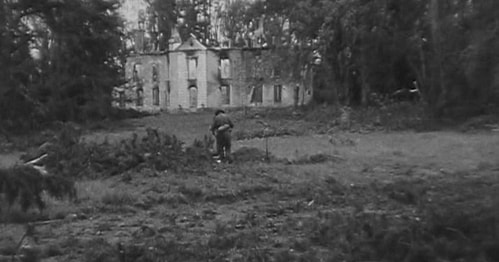
Through the Regimental Grapevine, we learn that a short film about the 1st Battalion's actions at the Chateau de la Londe on 28th June 1944, is to be aired soon.
The film, which has been commissioned by the Trustees of the Suffolk Regiment Museum, is to compliment the film they made about the 1st Battalions attack on Hillman Bunker that was released in 2016.
For a complex, confused and multi-faceted battle, we hope the film will draw all the elements of the action together. So often, 'B' Company is mentioned in isolation, yet 'C' Company suffered similar casualties advancing beside then, as did 'D' Company who came later to reinforce them as the battle continued. With precious few personal accounts and photographs available, we hope they do justice to the actions of the Regiment that day. The campaign was so ferocious that it still stands as the largest loss, killed wounded, missing and prisoners during the entire campaign. NB: The image here taken the following day, shows the wrecked chateau at Le Petit Londe, which was never rebuilt. It was 250 yards north of the Chateau de la Londe.
(Posted: 10/02/2019)
The film, which has been commissioned by the Trustees of the Suffolk Regiment Museum, is to compliment the film they made about the 1st Battalions attack on Hillman Bunker that was released in 2016.
For a complex, confused and multi-faceted battle, we hope the film will draw all the elements of the action together. So often, 'B' Company is mentioned in isolation, yet 'C' Company suffered similar casualties advancing beside then, as did 'D' Company who came later to reinforce them as the battle continued. With precious few personal accounts and photographs available, we hope they do justice to the actions of the Regiment that day. The campaign was so ferocious that it still stands as the largest loss, killed wounded, missing and prisoners during the entire campaign. NB: The image here taken the following day, shows the wrecked chateau at Le Petit Londe, which was never rebuilt. It was 250 yards north of the Chateau de la Londe.
(Posted: 10/02/2019)
Stanley's War
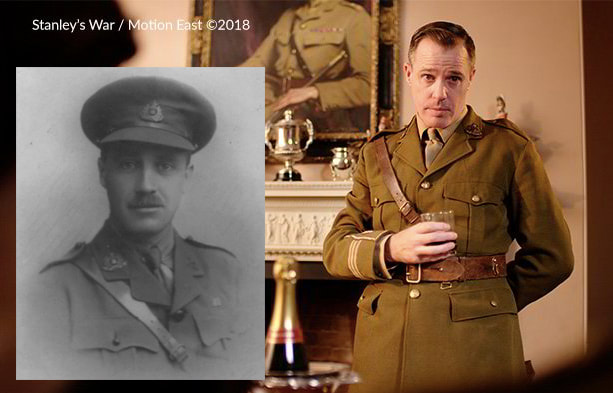
For those of you who are unaware, the rather excellent short movie 'Stanley's War' is now available to buy on DVD.
The film, which tells the story of Stanley Banyard, a young signaller from Hollesley, together with the courtship of Captain Frank Pretty, of 4th Suffolk, and his eventual wife, Edith Pretty, of later Sutton Hoo fame.
Intersperced with interviews, including one with our very own Chairman, Taff Gillingham, the story is an honest appraisal of how the Great War affected those in the County of Suffolk.
We can thoroughly recommend that you get yourself a copy, however, what happened to Frank's moustache?!
(Posted: 05/08/2019)
The film, which tells the story of Stanley Banyard, a young signaller from Hollesley, together with the courtship of Captain Frank Pretty, of 4th Suffolk, and his eventual wife, Edith Pretty, of later Sutton Hoo fame.
Intersperced with interviews, including one with our very own Chairman, Taff Gillingham, the story is an honest appraisal of how the Great War affected those in the County of Suffolk.
We can thoroughly recommend that you get yourself a copy, however, what happened to Frank's moustache?!
(Posted: 05/08/2019)
'Tiddler' Martin's Copy
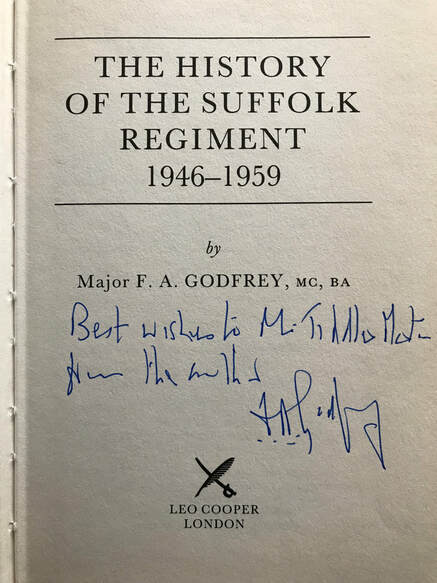
Today, on a windswept visit to Clacton, in a second-hand book shop we procured a copy of the fourth volume of Regimental History. In itself nothing to glamorous or special except that the author Major Bob Godfrey had signed it.
Bob Godfrey was a career soldier joining the Suffolk Regiment in 1949. In 1986, he was tasked to compile the last volume of Regimental History that was finally published in 1988. What is really nice about this copy is that Bob dedicated it to Regimental Stalwart, Walter 'Tidler' Martin.
Tidler Martin had a long and distinguished career with the Suffolk Regiment. He enlisted aged 15 into the 1st Battalion in 1935, then stationed in Plymouth, where he joined the Band. Two years later, he was transferred to the 2nd Battalion in India and served with them until 1943 when he was posted home. He then joined the band of the 1st Battalion that had remained at the Depot whilst the 1st Battalion were training in Scotland and in 1945 after VJ Day, he was transferred to the 31st Battalion, then in Gibraltar. He rejoined the 1st Battalion in Palestine in 1946 and after a brief spell with 1st Battalion, Essex Regiment, he was demobbed in 1950.
In later years, Tiddler was the Secretary of the Bury St. Edmunds Branch of the Old Comrades Association for over twenty years, until ill health forced him to retire. He died in 2005.
We remember Tiddler at Minden Day over fifteen years ago, in a wheelchair but proudly wearing his medals and Regimental tie, so its nice to have been able to secure his copy of the Regimental History that spanned the majority of his service with the Regiment.
(Posted: 27/01/2019)
Bob Godfrey was a career soldier joining the Suffolk Regiment in 1949. In 1986, he was tasked to compile the last volume of Regimental History that was finally published in 1988. What is really nice about this copy is that Bob dedicated it to Regimental Stalwart, Walter 'Tidler' Martin.
Tidler Martin had a long and distinguished career with the Suffolk Regiment. He enlisted aged 15 into the 1st Battalion in 1935, then stationed in Plymouth, where he joined the Band. Two years later, he was transferred to the 2nd Battalion in India and served with them until 1943 when he was posted home. He then joined the band of the 1st Battalion that had remained at the Depot whilst the 1st Battalion were training in Scotland and in 1945 after VJ Day, he was transferred to the 31st Battalion, then in Gibraltar. He rejoined the 1st Battalion in Palestine in 1946 and after a brief spell with 1st Battalion, Essex Regiment, he was demobbed in 1950.
In later years, Tiddler was the Secretary of the Bury St. Edmunds Branch of the Old Comrades Association for over twenty years, until ill health forced him to retire. He died in 2005.
We remember Tiddler at Minden Day over fifteen years ago, in a wheelchair but proudly wearing his medals and Regimental tie, so its nice to have been able to secure his copy of the Regimental History that spanned the majority of his service with the Regiment.
(Posted: 27/01/2019)
The Plague Of The Spanish Lady
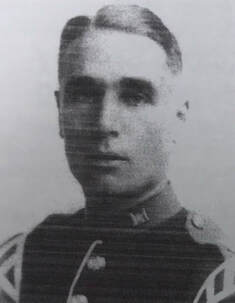
As the centenary of the Great War passes, it is important to remember the Spanish Flu pandemic of 1918-19, claimed the lives of many men of the Regiment who had served across the globe, only to die of its affects once the armistice was signed.
One such example was Private Leo Durant who died of pneumonia, brought on by the flu. The son of a law clerk, Leonard 'Leo' Durrant was born in Hadleigh and enlisted into the 4th Battalion in late November 1914. Almost certainly underage, there is evidence to suggest that he did not go to France until 1915. After being wounded, he recuperated and was back at the front. Upon being discharged in 1919, he promptly re-enlisted into the Norfolk Regiment, before he obtained a transfer to the 1st Battalion, then leaving for India.
After a course in Clerical Instruction, he was promoted Sergeant and from the photograph left, Leo appears to have been a member of the Band or the Corps of Drums, his scarlet uniform having the 'wings' of a musician. Leo died at that British Stationary Hospital at Putoyli in northern India. He is buried in Jutogh New Cemetery.
With grateful thanks to Hadleigh WW1 Project for the image of Leo.
(Posted:24/01/2019)
One such example was Private Leo Durant who died of pneumonia, brought on by the flu. The son of a law clerk, Leonard 'Leo' Durrant was born in Hadleigh and enlisted into the 4th Battalion in late November 1914. Almost certainly underage, there is evidence to suggest that he did not go to France until 1915. After being wounded, he recuperated and was back at the front. Upon being discharged in 1919, he promptly re-enlisted into the Norfolk Regiment, before he obtained a transfer to the 1st Battalion, then leaving for India.
After a course in Clerical Instruction, he was promoted Sergeant and from the photograph left, Leo appears to have been a member of the Band or the Corps of Drums, his scarlet uniform having the 'wings' of a musician. Leo died at that British Stationary Hospital at Putoyli in northern India. He is buried in Jutogh New Cemetery.
With grateful thanks to Hadleigh WW1 Project for the image of Leo.
(Posted:24/01/2019)
A Reunion Of A Very Different Kind
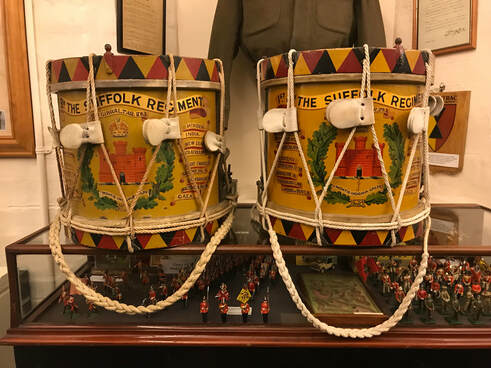
Recently, the effects of the later Brigadier H.P. Gardham were sold at auction in Kent. Amongst his possessions was a snare drum of the 1st Battalion from the period 1933-1954.
An identical drum can be seen at the Suffolk Regiment Museum, which is affectionately known as the 'Roubaix' Drum. The story of the Roubaix drums of the 1st Battalion is well known, but there whereabouts today are a little less well known.
Of eight drums reluctantly abandoned in France in 1940, three were subsequently recovered in 1944 and brought back into use with the Battalion. One of the three recovered Drums, was lost when the truck it was stored in suffered a direct hit before the Battalion crossed the Rhine in March 1945, leaving just two survivors.
When the Corps of Drums was reformed in 1948 in Greece, it was made up from four Drums that came out from the UK of a similar style. These had remained at the Depot in 1939 when the Battalion went to France. These Drums were later, it is believed, repainted in Trieste in 1953. Records show that two older 'Roubaix' Drums were we believe, sold off in 1947 to 'raise funds for new drums' and we believe that the Roubaix Drum at the Regimental Museum and the Brigadier's Drum, were these two older examples that were sold off .
Of twelve Drums originally painted in 1933, the Museum's Drum is No. 12 and Brigadier Gardham's Drum is No. 11. Both have their numbers carved into the hoops and stamped into the body of the Drum. The new owner of the Brigadier's Drum recently brought his Drum to the Regimental Museum, where for the first time since 1945 (when they all three Drums were last played together in the Belgian town of Haacht) it was reunited with its identical brother. Identical in every detail, even the year of manufacture, it was an historic reunion. It is known that there is another Drum of this style in existence in private hands, an escapee of the criminal repaint that occurred in the 1950s, and maybe one day, all three will come together again.
(Posted: 15/01/2019)
An identical drum can be seen at the Suffolk Regiment Museum, which is affectionately known as the 'Roubaix' Drum. The story of the Roubaix drums of the 1st Battalion is well known, but there whereabouts today are a little less well known.
Of eight drums reluctantly abandoned in France in 1940, three were subsequently recovered in 1944 and brought back into use with the Battalion. One of the three recovered Drums, was lost when the truck it was stored in suffered a direct hit before the Battalion crossed the Rhine in March 1945, leaving just two survivors.
When the Corps of Drums was reformed in 1948 in Greece, it was made up from four Drums that came out from the UK of a similar style. These had remained at the Depot in 1939 when the Battalion went to France. These Drums were later, it is believed, repainted in Trieste in 1953. Records show that two older 'Roubaix' Drums were we believe, sold off in 1947 to 'raise funds for new drums' and we believe that the Roubaix Drum at the Regimental Museum and the Brigadier's Drum, were these two older examples that were sold off .
Of twelve Drums originally painted in 1933, the Museum's Drum is No. 12 and Brigadier Gardham's Drum is No. 11. Both have their numbers carved into the hoops and stamped into the body of the Drum. The new owner of the Brigadier's Drum recently brought his Drum to the Regimental Museum, where for the first time since 1945 (when they all three Drums were last played together in the Belgian town of Haacht) it was reunited with its identical brother. Identical in every detail, even the year of manufacture, it was an historic reunion. It is known that there is another Drum of this style in existence in private hands, an escapee of the criminal repaint that occurred in the 1950s, and maybe one day, all three will come together again.
(Posted: 15/01/2019)
Happy 100th Birthday Wing Commander Perrens, D.S.O., O.B.E., D.F.C.!
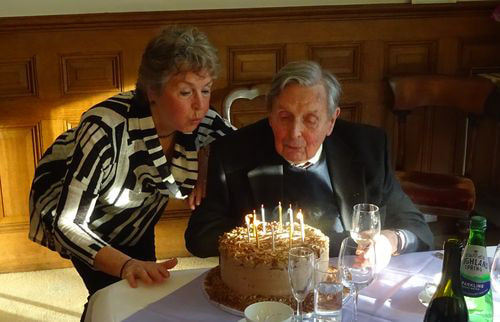
We heard today that Wing Commander Donald Perrens, DFC, celebrated his 100th Birthday on 9th January.
We had the honour to meet Wing Commander Perrens at Minden Day in 2010 where he became a Friends member. Since then we have researched his somewhat amazing career with both the Suffolk Regiment, and later the Royal Air Force.
Wing Commander Perrens went to France with the B.E.F. in 1939 and was one of the last men to leave. His escape route was through Cherbourg with a handful of men of 'B' Company who had been separated from the Battalion up in Belgium. Later after brief service as Adjutant to the newly reformed 8th Battalion, he transferred to the R.A.F. winning a DSO and a DFC for air operations in the Middle East.
To our most decorated living Suffolk soldier, we send our very best wishes and congratulations upon reaching his tenth decade!
(With most grateful thanks to Eastbourne College for the photograph above, which shows Donald and his daughter blowing out the candles on his birthday cake.)
(Posted: 10/01/2019)
We had the honour to meet Wing Commander Perrens at Minden Day in 2010 where he became a Friends member. Since then we have researched his somewhat amazing career with both the Suffolk Regiment, and later the Royal Air Force.
Wing Commander Perrens went to France with the B.E.F. in 1939 and was one of the last men to leave. His escape route was through Cherbourg with a handful of men of 'B' Company who had been separated from the Battalion up in Belgium. Later after brief service as Adjutant to the newly reformed 8th Battalion, he transferred to the R.A.F. winning a DSO and a DFC for air operations in the Middle East.
To our most decorated living Suffolk soldier, we send our very best wishes and congratulations upon reaching his tenth decade!
(With most grateful thanks to Eastbourne College for the photograph above, which shows Donald and his daughter blowing out the candles on his birthday cake.)
(Posted: 10/01/2019)
Colin Smith
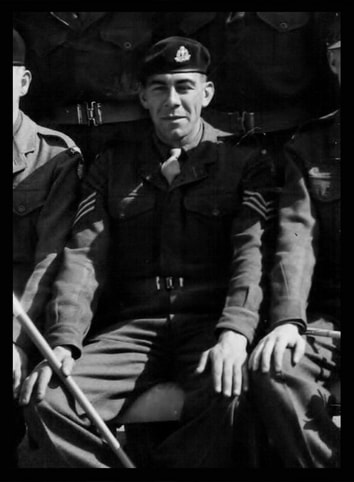
It was with sadness that we heard today of the passing of Suffolk Regiment stalwart Colin Smith, who passed away just before Christmas.
Colin’s military career began just after the Second World War when he joined the 5th (Cadet) Battalion of the Suffolk Regiment. He was a Cadet Bandsman who played with the Battalion Band in the 1947 Royal Tournament at Olympia.
Colin signed on as a regular soldier in 1951 and was soon serving with the 1st Battalion in Malaya. Here he joined Support Company, serving with the Anti-Tank Platoon with its impracticable 6 pdr. guns, then later with the Mortar Platoon. He returned to the UK with the Battalion in 1953 and became a Sergeant Instructor at the Depot. He served briefly with the 1st Battalion in Germany in 1955.
In later years, Colin carried the Bury St. Edmunds Branch Standard on many occasions and on one particular parade in London at the 60th anniversary of VJ Day, Colin had taken the trouble to ensure that the Standard was decked with Roses as is the custom when the Monarch is present.
Colin lived in later years at Whepstead and was instrumental in the refurbishment of the village War Memorial which contained one of the first three fatalities of the Great War, William Flack. He was also involved later in the creation of a Memorial Close of residential sheltered accommodation that was named in Flack's honour.
For the Regimental Historian, Colin was a wealth of knowledge on the minutiae of the dress and regulations. From trouser creases to blanco shades, and how low the trousers were worn above the webbing anklets, he knew most of it. From how to make a Drum Trace, to how to tension drum skins with potatoes, he remembered all of the tricks. He also knew the trick for folding the beret to keep the cap badge prominent and how to flatten the brass keepers on a webbing belt to make them easier to polish.
Colin was a loyal member of the Friends since it earliest days and was a dedicated Volunteer at the Regimental Museum. Colin helped tremendously with the revamp of the Regimental Museum and was always willing to show people around it many treasures, with a story and a memory of most of the exhibits. He was Chairman of the Bury St. Edmunds Branch of the Old Comrades Association and a member of the Sergeant Mess Dinner Club. He will be greatly missed.
Our thoughts are with his daughter and his family at this time.
(Posted: 11/01/2019)
Colin’s military career began just after the Second World War when he joined the 5th (Cadet) Battalion of the Suffolk Regiment. He was a Cadet Bandsman who played with the Battalion Band in the 1947 Royal Tournament at Olympia.
Colin signed on as a regular soldier in 1951 and was soon serving with the 1st Battalion in Malaya. Here he joined Support Company, serving with the Anti-Tank Platoon with its impracticable 6 pdr. guns, then later with the Mortar Platoon. He returned to the UK with the Battalion in 1953 and became a Sergeant Instructor at the Depot. He served briefly with the 1st Battalion in Germany in 1955.
In later years, Colin carried the Bury St. Edmunds Branch Standard on many occasions and on one particular parade in London at the 60th anniversary of VJ Day, Colin had taken the trouble to ensure that the Standard was decked with Roses as is the custom when the Monarch is present.
Colin lived in later years at Whepstead and was instrumental in the refurbishment of the village War Memorial which contained one of the first three fatalities of the Great War, William Flack. He was also involved later in the creation of a Memorial Close of residential sheltered accommodation that was named in Flack's honour.
For the Regimental Historian, Colin was a wealth of knowledge on the minutiae of the dress and regulations. From trouser creases to blanco shades, and how low the trousers were worn above the webbing anklets, he knew most of it. From how to make a Drum Trace, to how to tension drum skins with potatoes, he remembered all of the tricks. He also knew the trick for folding the beret to keep the cap badge prominent and how to flatten the brass keepers on a webbing belt to make them easier to polish.
Colin was a loyal member of the Friends since it earliest days and was a dedicated Volunteer at the Regimental Museum. Colin helped tremendously with the revamp of the Regimental Museum and was always willing to show people around it many treasures, with a story and a memory of most of the exhibits. He was Chairman of the Bury St. Edmunds Branch of the Old Comrades Association and a member of the Sergeant Mess Dinner Club. He will be greatly missed.
Our thoughts are with his daughter and his family at this time.
(Posted: 11/01/2019)
Happy New Year
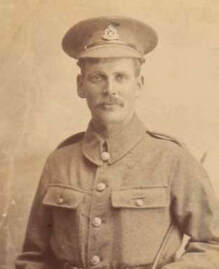
A very Happy New Year to all Friends.
2019 looks set to be another good year for the Friends. We are well on the way to organising another trip to Holland, planned for September, and they'll be lots of other great Suffolk Regiment-related news we're sure.
Keep checking back to see what we're up to and what happening and don't forget to follow us on both Facebook and Twitter, or better still if you're not a member, pop along to the Membership page to download a membership form and join us!
(Posted: 01/01/2019)
2019 looks set to be another good year for the Friends. We are well on the way to organising another trip to Holland, planned for September, and they'll be lots of other great Suffolk Regiment-related news we're sure.
Keep checking back to see what we're up to and what happening and don't forget to follow us on both Facebook and Twitter, or better still if you're not a member, pop along to the Membership page to download a membership form and join us!
(Posted: 01/01/2019)
